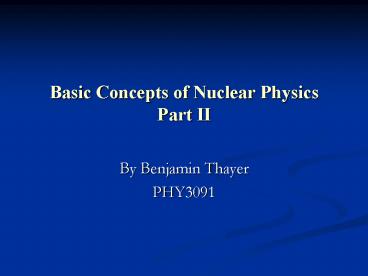Basic Concepts of Nuclear Physics Part II
Title:
Basic Concepts of Nuclear Physics Part II
Description:
... are highly radioactive and produce further energy by their radioactive decay ... This process is hindered by Coulomb repulsive forces ... –
Number of Views:241
Avg rating:3.0/5.0
Title: Basic Concepts of Nuclear Physics Part II
1
Basic Concepts of Nuclear PhysicsPart II
- By Benjamin Thayer
- PHY3091
2
Topics
- Interactions involving neutrons
- Nuclear Fission
- Nuclear Reactors
- Nuclear Fusion
3
Interactions Involving Neutrons
- As neutrons are electrically neutral, they do not
interact electrically with electrons - Rate of neutron induced reactions increase as the
neutron KE increases - When a neutron is absorbed by atomic nuclei of
matter - decays by nuclear forces
4
Interactions involving Neutrons
- Neutron Capture
- If a fast neutron (energygt 1MeV) travels through
matter collides with other nuclei - Loses KE with each collision
- If this KE becomes low neutron is absorbed by a
nucleus - The nucleus becomes unstable (for a very short
time) and emits gamma radiation to stabilize
5
Interactions Involving Neutrons
- Neutron Capture
- The product nucleus is radioactive
- Decays by beta emission
- Rate of capture depends on
- Type of atoms in the target matter
- Energy of the incident neutrons
6
Moderators
- Materials in which the elastic collision between
the atoms and neutrons dominate - They slow down the neutrons effectively
- As the rate of capture increases with decrease in
the neutron energy, the material should have low
capture tendency - Moderator nuclei should have low mass
- which have abundance of hydrogen (paraffin
water are 2 examples)
7
Moderators
- Fermi discovered that when some elements were
bombarded by neutrons, new radioactive elements
were produced. - He predicted that neutron would be a good
projectile. As it is uncharged, it would not
experience Coulombs force while approaching the
nucleus - Neutrons become thermal neutrons
- They are in thermal equilibrium with the
moderator material - As the RMS speed of the thermal neutrons is 2800
m/s, they have a high probability of being
captured - Compare that speed with the speed of the incident
neutron whose kinetic energy is of the order of
several MeV - The process is called thermalistation
8
Nuclear Fission
9
Nuclear Fission
- When a U-235 nucleus absorbs a thermal neutron,
it produces a compound nucleus of U-236 - This nucleus undergoes fission, splitting into
two fragments
10
Nuclear Fission
11
Nuclear Fission
12
Nuclear Fission (Chain Reaction )
- If an least one neutron from U-235 fission
strikes another nucleus and causes it to fission,
then the chain reaction will continue - If the reaction will sustain itself, it is said
to be "critical", and the mass of U-235 required
to produced the critical condition is said to be
a "critical mass - A fission chain reaction produces intermediate
mass fragments which are highly radioactive and
produce further energy by their radioactive decay
13
Nuclear Fission (Chain Reaction )
- Some of them produce neutrons, called delayed
neutrons, which contribute to the fission chain
reaction. - The probability for fission with slow neutrons is
greater - If the neutrons from fission are moderated to
lower their speed, a critical chain reaction can
be achieved at low concentrations of U-235
14
Nuclear Reactors
15
Nuclear Reactors
- Reproduction Constant K
- Average number of neutrons from each fission
event that causes another fission event - For normal fission reaction, K 2.5
- Less because of several factors
- K 1 gives a self-sustained chain reaction
reactor is called critical - K lt 1, the reactor is sub critical reaction
dies out - Kgt1, the reactor is supercritical and a
un-stoppable reaction occurs
16
Nuclear Reactors
17
Nuclear Reactors
18
Nuclear Reactors
- Current uses of nuclear energy must rely on
nuclear fission, a less-than-ideal energy source,
since nuclear fusion has yet to be harnessed for
electricity generation. The heat from the nuclear
fission is used to - This usually done in a Boiling Water Reactor
(BWR) or a Pressurized Water Reactor (PWR), but
there are other options such as the fast breeder
reactor
19
Nuclear Fusion
- Opposite of nuclear fission
- Energy will be released if two lighter nuclei
combine to form a larger nucleus, a process is
called nuclear fusion - This process is hindered by Coulomb repulsive
forces - The Coulomb barrier is broken by raising the
temperature of the material until the particles
have enough energy (Sun)































